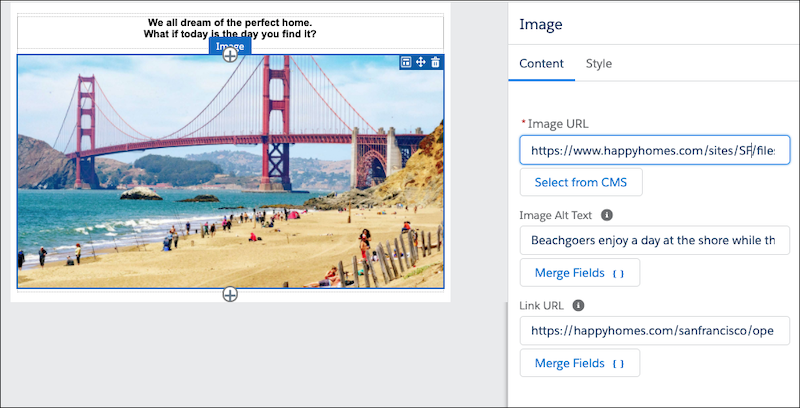Salesforce CMS is the content management system Salesforce products leverage. Salesforce CMS is used for storing and accessing documents, images, videos, knowledge articles, and more, as a central repository for your org. Following Salesforce’s intergated platform ideology – any assets stored in this app can be accessed by multiple groups of users, regardless of which ‘cloud’ product they are using.
Salesforce CMS is a Lightning Experience app. Originally built for omni-channel content delivery to different ‘experiences’ (think Salesforce Communities/Experience Cloud, Salesforce Commerce Cloud), the app is now being embedded at many points in the Salesforce user experience, especially the role it plays in the Lightning Content Builder.
There’s no better time to learn about Salesforce CMS. For the past few years, Pardot has been transitioning on to the core Salesforce platform, which means that it can leverage a number of Salesforce features. The new Lightning Email Builder for Pardot is a perfect example. Pardot users will store images in Salesforce CMS, and fetch them when building emails. It will put an end to Pardot files (limited storage) or other externally hosted workarounds.
No doubt there will be plenty of questions coming about the app and how it works with Pardot! This post will give you an overview and hopefully answer some of your questions.

Source: Salesforce CMS for Lightning Content Builder
How to Access Salesforce CMS?
Salesforce CMS is a Lightning Experience app, which means it can be launched from the App Launcher (that ‘waffle’ icon at the top left of the screen).
“The Salesforce CMS app and its tabs are now enabled by default in the App Launcher for new Salesforce orgs and all standard user profiles”

Source: Salesforce CMS Apps and Tabs Are Enabled by Default
This is what the blank CMS Home page looks like:

And here is what it looks like in action:

Source: Salesforce CMS Enhancements video
Let’s pause here for a moment. Salesforce CMS works like a platform ‘service’ that the Salesforce ‘cloud’ products leverage, for example, Salesforce Marketing Cloud, Community Cloud, and soon, the Lightning Content Builder. As a result, users will access the app from multiple points in the Salesforce user experience (not just from CMS Home).
CMS Workspaces
Workspaces are used to control user access to content. Similar to Business Units in Marketing Cloud or Pardot, you can arrange workspaces by projects, regions, or teams.
Users that are part of a workspace become ‘contributors’, who can create and manage access to content. Language settings and channels (coming next) are also defined for each workspace.

Find out more about how to create a workspace and how user access works here.
CMS Channels
Each workspace will have one or more channels. These share the content with ‘endpoints’ where the content is published, such as:
- Lightning Content Builder,
- Commerce Cloud,
- Marketing Cloud Journey Builder,
- Heroku,
- Lightning experience apps,
- Experience Builder (in Experience Cloud, formerly Community Cloud),
- Any other third-party site (using headless APIs)

Source: Create a CMS Channel in Salesforce CMS
Hybrid CMS
You may come across the term ‘Hybrid CMS’ when doing more research. This means that the assets stored in this app can be distributed to various digital touch-points (and so, are not only restricted to the Salesforce endpoints listed above).
You can create content collections, which have been described like playlists that can be applying to your different digital experiences.
What’s Next for Salesforce CMS + Pardot?
As I mentioned, there’s no better time to learn about Salesforce CMS. The new Lightning Email Builder for Pardot will leverage this app, where Pardot users will store images (etc.), and fetch them when building emails.
Salesforce CMS integrated will put an end to Pardot files (limited storage) or other externally hosted workarounds, which has been a long-standing pain point for Pardot customers.
See this article for how to Configure Salesforce CMS to Use Images in Emails.
There are still a few questions left open. Although we don’t have the answers to them yet, they things you should start thinking about:
- The migration process: can we still host images in Pardot or must we move to Salesforce CMS?
- Working in line with other Pardot features, such as can we add completion actions to content hosted in SF CMS?

